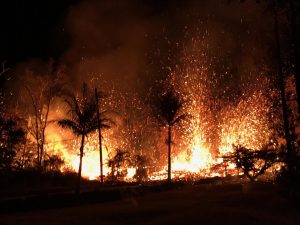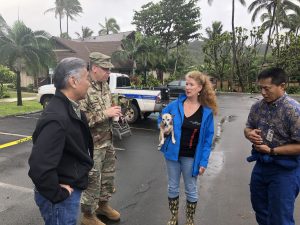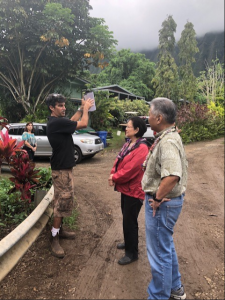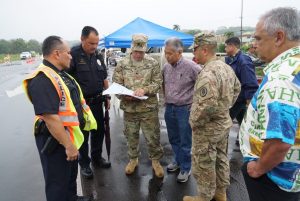Governor moves decisively on disaster response
Posted on May 30, 2018 in FeaturedFirst it was devastating floods on Kaua‘i and O‘ahu. Then the 6.9 earthquake and Kīlauea eruption on Hawai‘i island, with red-hot lava and toxic fumes threatening residents in Lower Puna. Governor Ige has been on the ground to work with county officials, reassure communities, and move quickly on disaster declarations and recovery efforts.

On the Big Island, lava fountains as high as 230 feet erupted from fissures in Leilani Estates subdivision.
A Presidential Disaster Declaration for Hawai‘i island was approved just one day after the governor submitted the request. That means federal assistance will be available to repair public roads, parks and schools damaged by the eruption and earthquakes. The governor said he also wanted the state to be ready in case a large-scale evacuation of Puna residents is needed.
“These lava fissures are opening on key arteries and highways,” said the governor when he was at Leilani Estates on Hawai‘i Island. “If we lost those, the community would be isolated, just as in Wainiha and Hāʻena (on Kaua‘i) when Kūhiō Highway and other roads became impassable. We would have to find other ways to evacuate residents. A mass evacuation of the lower Puna District would be beyond current county and state capabilities and would quickly overwhelm our collective resources.” Since the start of the eruption May 3, the lava has destroyed more than 90 structures, covered hundreds of acres of land, and left many families wondering what their future holds.

On Kaua’i, Laura Richards, general manager of the Hanalei Colony Resort met with Governor Ige, Maj.Gen. Joe Logan of the Hawai’i National Guard and Elton Ushio of Kaua’i Emergency Management.
The president also approved a Major Disaster Declaration for emergency repair of damaged public facilities in Kaua‘i County and the City and County of Honolulu. In addition, Governor Ige signed a flood recovery bill that sets aside $100 million to help with repairs to roads and bridges on Kaua‘i and $25 million on O‘ahu. Emergency federal and state loans are also available for affected farmers. The request for individual federal assistance to homeowners is pending, based on a review of damages.
To protect public safety on the Big Island, the governor also took action on a “more comprehensive approach” to mitigate risks posed by two concerns at Puna Geothermal Venture (PGV): quick removal off-site of 60,000 gallons of pentane, a flammable liquid used in the production of geothermal power, and “quenching” the geothermal wells themselves to prevent a blow-out.
“I asked Mayor Harry Kim and Tom Travis of HI-EMA to lead a team to work with PGV to evaluate the risks and reach out to national experts,” explained the governor. He said he took the action because at a community meeting he attended “clearly that was the biggest concern expressed by residents. We wanted to be certain we had the authority to act decisively and be proactive.”
In addition to all this, scientists at the Hawaiian Volcano Observatory have issued warnings about steam-powered blasts from Kilauea’s summit, threatening other nearby areas with huge ash plumes and falling rocks. Governor Ige said he understands the anxiety people are feeling and wanted to offer some reassurance. “I want residents to know that the state, county and federal government are committed to keeping our community safe, first and foremost,” said the governor. “We’re working to mitigate the risks as best we can and help people rebuild their lives as quickly as possible.”



